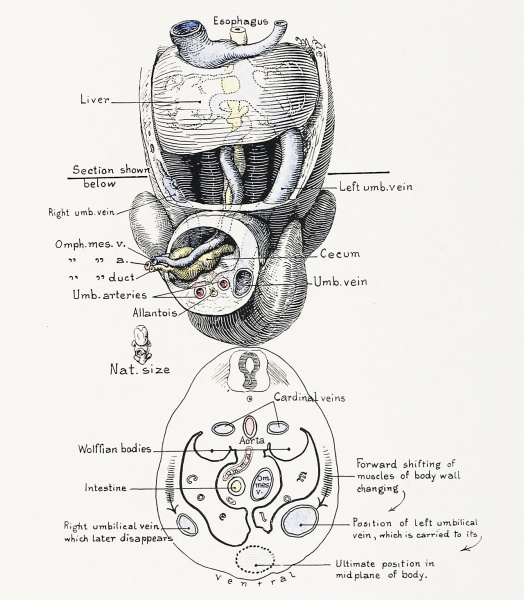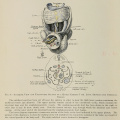File:Cullen1916 fig06.jpg

Original file (1,280 × 1,465 pixels, file size: 309 KB, MIME type: image/jpeg)
Fig. 6. Anterior View and Transverse Section of a Human Embryo 7 mm Long
Showing the Umbilical Region.
The umbilical cord has been cut off near the embryo in order to show the thick lower portion containing the umbilical vessels and allantois. The upper portion consists mainly of the exoccelomic cavity, which contains the intestinal loop and the omphalomesenteric vessels. The omphalomesenteric duct has been drawn to the right, in order that it may be more clearly seen. Note the narrow ccelomic ring through which the intestine and vessels emerge. At the outer end of the intestinal loop the omphalomesenteric duct begins.
The lower diagram represents a transverse section of the body at the level indicated in the upper picture. The purpose of this diagram is to show the shifting of the left umbilical vein toward the mid-line of the body, as a result of the ventral growth of the body-wall. The right umbilical vein is destined to disappear.
| Historic Disclaimer - information about historic embryology pages |
|---|
| Pages where the terms "Historic" (textbooks, papers, people, recommendations) appear on this site, and sections within pages where this disclaimer appears, indicate that the content and scientific understanding are specific to the time of publication. This means that while some scientific descriptions are still accurate, the terminology and interpretation of the developmental mechanisms reflect the understanding at the time of original publication and those of the preceding periods, these terms, interpretations and recommendations may not reflect our current scientific understanding. (More? Embryology History | Historic Embryology Papers) |
- Figure Links: 1 Human embryo 0.7 mm | 2 Human embryo 1.7 mm | 3 Human embryo 2.5 mm | 4 Human embryo 3.5 mm | 5 Human embryo 5 mm | 6 Human embryo 7 mm | 7 Human embryo 7 mm | 8 Human embryo 10 mm | 9 Human embryo 12.5 mm | 10 Human embryo 10 mm | 11 Human embryo 23 mm | 12 Human embryo 3 cm | 13 Human embryo 4.5 cm sagittal | 14 Human Embryo 4.5 cm | 15 Human Embryo 5.2 cm | 16 Human Embryo 6.5 cm | 17 Human Embryo 7.5 cm | 18 Human Embryo 9 cm | 19 Human Embryo 10 cm | 20 Human Embryo 12 cm | 21 Human Embryo 12 cm | 22 Human Embryo 12 cm | 23 Human Embryo 12 cm Cord | 28 Fetus Five Months | 30 Ventral Heria | 31 Human Embryo 5.5 cm | 32 Term Human | 33 Term Human | [[Figures
Reference
Cullen TS. Embryology, anatomy, and diseases of the umbilicus together with diseases of the urachus. (1916) W. B. Saunders Company, Philadelphia And London.
Cite this page: Hill, M.A. (2024, April 27) Embryology Cullen1916 fig06.jpg. Retrieved from https://embryology.med.unsw.edu.au/embryology/index.php/File:Cullen1916_fig06.jpg
- © Dr Mark Hill 2024, UNSW Embryology ISBN: 978 0 7334 2609 4 - UNSW CRICOS Provider Code No. 00098G
File history
Click on a date/time to view the file as it appeared at that time.
| Date/Time | Thumbnail | Dimensions | User | Comment | |
|---|---|---|---|---|---|
| current | 16:45, 27 October 2018 |  | 1,280 × 1,465 (309 KB) | Z8600021 (talk | contribs) | |
| 16:44, 27 October 2018 |  | 2,146 × 2,147 (675 KB) | Z8600021 (talk | contribs) |
You cannot overwrite this file.
File usage
The following 3 pages use this file:
